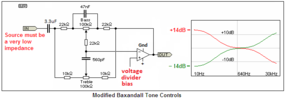1) Can I share the VDD/2 Vref point with another OPamp? Or do I need to add another resister divider & give to the other OPAMP seperately?
2) What will be happen if I give the wiper pin of volume controller to OPAMP side & take one corner pin to power amp?Or my drawing is correct?



